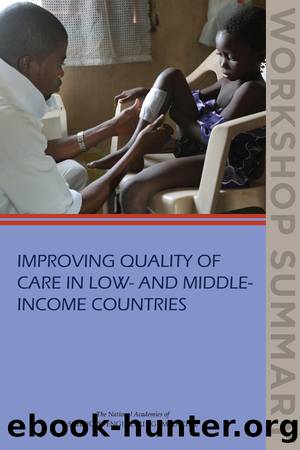Improving Quality of Care in Low- and Middle-Income Countries: Workshop Summary by Gillian J. Buckley

Author:Gillian J. Buckley
Language: eng
Format: epub
Publisher: The National Academies Press
Published: 2015-12-04T00:00:00+00:00
Component of national quality improvement system Number of countries (%)
Mandatory continuing medical education or continuing professional development 16 (61.5)
Mandatory hospital accreditation 8 (30.8)
Voluntary hospital accreditation 13 (50.0)
Technology assessment studies on medicines 15 (57.7)
Standards on safe blood use 23 (88.5)
Pharmacovigilance system 21 (80.8)
SOURCES: Klazinga, 2015; OECD and WHO, 2014.
There was also discussion of the best ways to measure quality in the poorest countries. Information technology, though full of promise, is going to remain out of reach for the poorest patients, many of whom are treated in their homes or in rural clinics. A participant pointed out that only half of the worldâs newborns are even weighed at birth and asked how, in such settings, we can ensure reliable information on chronic disease. Klazinga agreed and suggested that the most realistic first steps would be developing basic death registries and then cancer registries. He cited success from South America where cancer registries have developed rapidly over the past 5 years.
AT WHAT COST?: WHAT MAKES A PROGRAM COST-EFFECTIVE
In the last panel discussion of the day, Edward Broughton of URC and Dinesh Nair of the World Bank discussed cost-effectiveness and feasibility in quality improvement. Broughton opened his presentation with a simple example of cost-effectiveness in health. If a person knows his or her likelihood of getting sick, weighing the costs of treatment against foregone wages is relatively simple. But in quality improvement, although the basic principle is the same, the analysis gets complicated quickly. For example, if the USAID mission to Liberia did a quality improvement program in connection to the Ebola response, the epidemiology of Ebola would not be the only thing changing in the health system. Clinics that treat Ebola patients presumably treat others as well; attention to these conditions would improve, suffer, or stay the same (see Figure 4-5). Cost-effectiveness analysis needs information on the cost and health consequences of all those variables. Usually, as Figure 4-5 shows, the analysis accounts for costs and consequences associated with improving or not improving treatment. Accounting for changes in mortality requires sophisticated epidemiological modeling. Modeling depends on assumptions that are invariably debatable, leaving the final conclusions open to criticism.
For one thing, it is difficult to say how long the effects of a quality improvement intervention last. The initial intervention might go on for 6 months to 2 years. Modeling must make assumptions about how the improvements will continue after the technical experts leave. While it is probably not sensible to assume processes return to baseline after the project, it is also imprudent to suppose that all gains are sustained. Sometimes the local host agency expands the program after the USAID implementing partner leaves. Estimating cost-effectiveness requires making assumptions about how effective the implementation will be with different technical staff in charge. Finally, Broughton stressed that cost-effectiveness analysis generally takes the perspective of the costs to the funderâin the case of his organization that means the cost to USAID. A stronger model would consider the costs to society and thereby give the host country ministry the information it needs to determine cost-effectiveness.
Download
This site does not store any files on its server. We only index and link to content provided by other sites. Please contact the content providers to delete copyright contents if any and email us, we'll remove relevant links or contents immediately.
Human Diseases (MindTap Course List) (by Team-IRA) by Marianne Neighbors Ruth Tannehill-Jones(844)
The Neglected Dimension of Global Security: A Framework to Counter Infectious Disease Crises by National Academy of Medicine Secretariat(421)
Statistical Methods in Health Disparity Research by J. Sunil Rao(399)
Imaging in Urology by Mitchell Tublin MD Joel B Nelson MD(394)
Short Course in Medical Terminology by Nath Judi L.;(331)
Wilkins' Clinical Practice of the Dental Hygienist by Boyd Linda D.;Mallonee Lisa F.; & Lisa F. Mallonee(301)
Clinical Research in Occupational Therapy, Sixth Edition by Martin Rice;(300)
Cancer Cell Culture by Unknown(300)
Murray's Basic Medical Microbiology E-Book by Murray Patrick R.;(282)
Anatomical Kinesiology by Gross Michael;(281)
Psychedelics As Psychiatric Medications by Nutt David;Castle David;(272)
Neuroscience Fundamentals for Rehabilitation by Lundy-Ekman Laurie(270)
Health Behavior: Theory, Research, and Practice by Karen Glanz & Barbara K. Rimer & K. Viswanath(269)
Rang & Dale's Pharmacology 9th Edition plus Flashcards 2nd Edition by Unknown(250)
Achieving Procreation : Childlessness and IVF in Turkey by Merve Demircioğlu Göknar(247)
Public Health and Society: Current Issues by Burke Lillian D.;Weill Barbara;(246)
The Handbook of Medicinal Chemistry by Simon E Ward;Andrew Davis;(245)
Primary Care Occupational Therapy by Unknown(238)
From Good Schools to Great Schools by Susan P. Gray & William A. Streshly(232)
